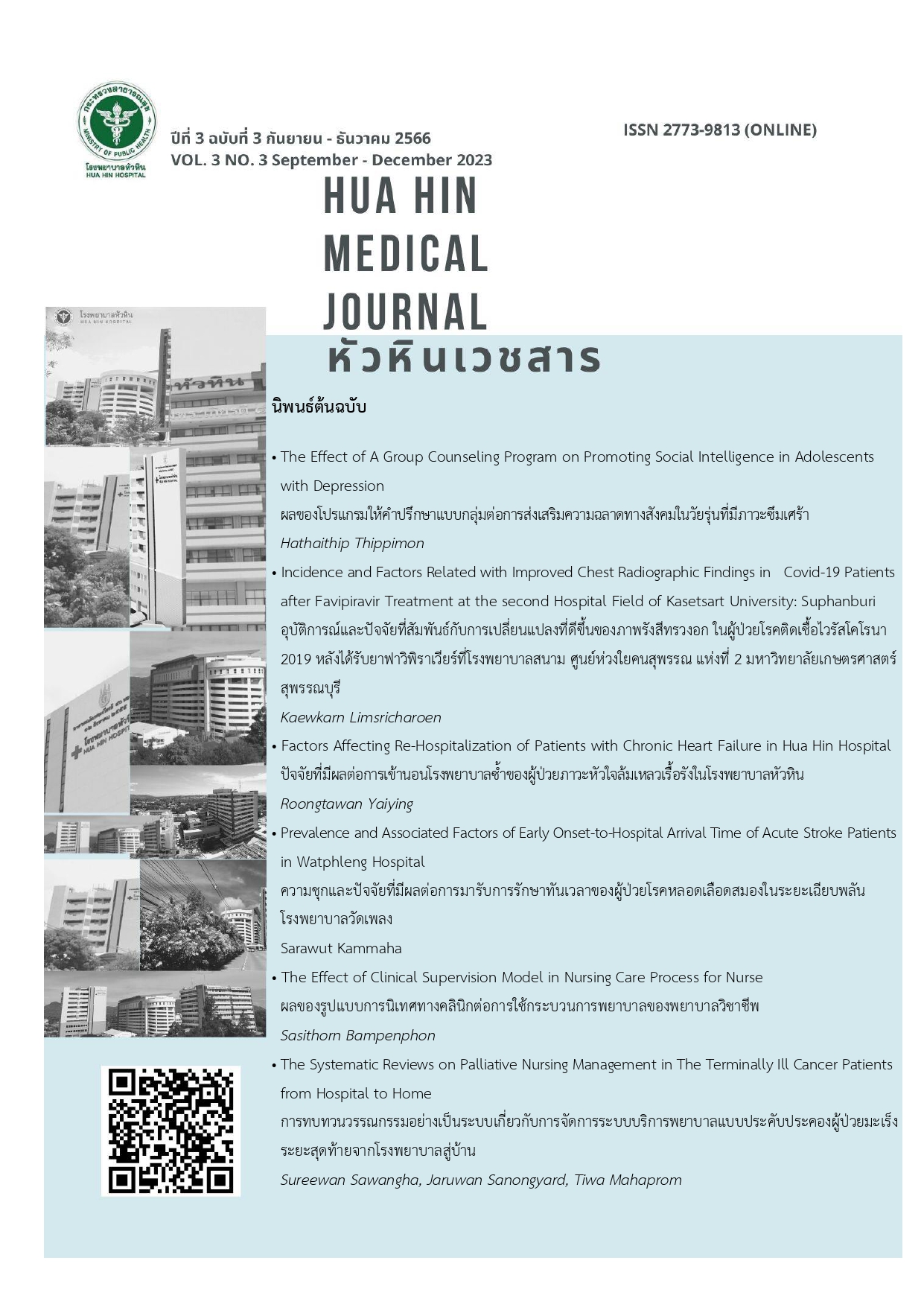The Systematic Reviews on Palliative Nursing Management in The Terminally Ill Cancer Patients from Hospital to Home
Keywords:
palliative nursing management, Home Care in Cancer Patients, palliative CareAbstract
Background: Patients with cancer who are in the terminal stage are at high risk of death. These patients must return home for palliative care until their last days. Therefore, there is a need for a patient treatment service system to manage and coordinate treatment between hospitals and homes for efficient and continuous nursing.
Objectives: This report is a literature review with the purpose to summarize the practice methods and results of palliative care at home.
Methods: The research method is studying the existing research results published between the years 2017 and 2022, from May 2022 to April 2023, using the electronic databases of Thai journals, namely TCIJO and Thai LIS Digital Collection, and following the PICOS Framework concept of Joanna Briggs Institute.
Materials: The quality analysis of the research study was conducted using the Review Manager software for a quasi-experimental study assessment, following the Checklist for Quasi-Experimental Studies: non-randomized experimental studies. Subsequently, the data was subjected to statistical analysis using Meta-analysis, and content analysis was performed to address the literature review questions.
Results: The search results from the keyword search yielded a total of 226 research reports. Among these, 219 were from the TCIJO database, and 7 were from the Thai LIS Digital Collection. Six studies met the criteria for literature review based on the PICOS framework: 3 quasi-experimental studies and 3 operational studies. The research quality levels were rated as TCI 1 and 2, with three studies falling into each category. However, the statistical results were insufficient for Meta-analysis, so content analysis was performed instead. The study focused on two models of patient care service systems for end-stage cancer patients transitioning from hospitals to home care. The first model was case management, and the second model involved network and family participation. The results indicated an improvement in the quality of care with the implementation of the Palliative Care Outcome Scale (POS). There was no significant difference in the measured physical performance (palliative performance scale: PPS) between the two models, but the group receiving care in the emergency department had fewer hospital admissions and shorter hospital stays compared to the control group. Additionally, the palliative care at home continuity led to an overall improvement in the patient's quality of life.
Conclusions: The patient care service system model of transitioning end-stage cancer patients from hospitals to home care, with the involvement of healthcare professionals and working as a network from hospital to home, promotes and supports patients and caregivers in self-care management, leading to an improved quality of life. This positively benefits the patients, their families, and the hospitals and aligns with the policies of the Ministry of Public Health.
References
กระทรวงสาธารณสุข รายงานตามตัวชี้วัดกระทรวงปี 2565.กลุ่มรายงานมาตรฐานข้อมูลเพื่อตอบสนอง Service Plan สาขา Intermediate & Palliative Care:ร้อยละของผู้ป่วยประคับประคองที่ได้รับการดูแลต่อเนื่องที่บ้าน. เข้าถึงเมื่อ15 กรกฎาคม 2565.เข้าถึงได้จากhttps://hdcservice.moph.go.th/hdc/reports.
กรมการแพทย์กระทรวงสาธารณสุข. แผนยุทธศาสตร์สถาบันมะเร็งแห่งชาติ พ.ศ.2562 –2565.กรุงเทพฯ: สถาบันมะเร็งแห่งชาติ; 2562.41-51.
อรพรรณ ไชยเพชร, กิตติกร นิลมานัต และวิภาวี คงอินทร์. ประสบการณ์ของพยาบาลไอซียูในการดูแลผู้ป่วยใกล้ตาย. วารสารสภาการพยาบาล. 2554; 26(1): 41-55.
WHO Palliative care. Global Health Observatory; 2018 [2020 Jul 4]. Available from: https://www.who.int/news-room/fact-sheets/detail/palliative-care.
สำนักงานกองทุนสนับสนุนการสร้างเสริมสุขภาพ. การดูแลแบบประคับประคอง เพื่อคุณภาพชีวิตที่ดีของผู้ป่วยในวาระสุดท้าย 2565.https://resourcecenter.thaihealth.or.th/article
กรมการแพทย์กระทรวงสาธารณสุข. คู่มือการดูแลแบบประคับประคองและระยะท้ายสำหรับบุคลากรทางการแพทย์.: กรุงเทพฯ: โรงพิมพ์องค์การสงเคราะห์ทหารผ่านศึกในพระบรมราชูปถัมภ์; 2563.85-110.
Pitchayapa Pornrattanakavee, Tassaya Srichan, Kasan Seetalarom, Siriwimon Saichaemchan, Nittha Oer areemitrand Naiyarat Prasongsook. Impact of interprofessional collaborative practice in palliative care on outcomes for advanced cancer inpatients in a resource-limited setting. BMC Palliative Care. 2022;21(229):2-9.
ปทิตตา นึกเว้น, ขนิตฐา หาญประสิทธิ์คำและธิราภรณ์ จันทร์ดา.การรับรู้และการปฏิบัติของพยาบาลต่อการดูแลแบบประคับประคอง.วารสารพยาบาลโรคหัวใจและทรวงอก.2559; 27(1):128-141.
มยุรี สุขุปัญญารักษ์, อุทุมพร มาลัยทอง, นุชนาถ ไกรรัตน์เจริญ และสุพิชา อาจคิดการ. การพัฒนารูปแบบการดูแลแบบประคับประคองสำหรับผู้ป่วยโรคมะเร็ง.2018;35(1):65-74.
อัจฉรา คำมะทิตย์ และ มัลลิกา มากรัตน์. การทบทวนวรรณกรรมอย่างเป็นระบบ: วิธีการปฏิบัติทีละขั้นตอน. วารสารเครือข่ายวิทยาลัยพยาบาลและการสาธารณสุขภาคใต้ 2559; 3(3): 246-259.
สำนักงานปลัดกระทรวงสาธารณสุข: สำนักบริหารการสาธารณสุข. คู่มือแนวทางการดำเนินงานคลินิกหมอครอบครัวสำหรับหน่วยบริการ.กรุงเทพฯ :โรงพิมพ์ชุมนุมสหกรณ์แห่งประเทศไทย;2559.5-10.
รัตนาภรณ์ รักชาติและคณะ. การพัฒนารูปแบบการดูแลผู้ป่วยมะเร็งแบบประคับประคองและระยะท้าย โดยการมีส่วนร่วมของเครือข่ายชุมชนต้นแบบหมู่บ้านปลอดมะเร็งจังหวัดลำปาง.วารสารการพยาบาลและสุขภาพ สสอท.2565;4(2)1-19.
ภิญโญ อุทธิยา, ขวัญใจ อำนาจสัตย์ซื่อ, พัชราพร เกิดมงคลและพิชัย จันทร์ศรีวงศ์. ผลของโปรแกรมการจัดการรายกรณีผู้ป่วยสูงอายุโรคมะเร็งระยะสุดท้ายในชุมชน. สาธารณสุขศาสตร์. 2561;48(3):371-384.
ช่อผกา ปุยขาว,สุรีพร ธนศิลป์และจรรยา ฉิมหลวง. ผลของโปรแกรมการมีส่วนร่วมของครอบครัวต่อคุณภาพชีวิตในผู้ป่วยมะเร็งระยะสุดท้าย. วารสารเกื้อการุณย์. 2562;26(2):93-106.
ศรีรัตน์ มากมาย, พรรณี สิทธิโน และสีดา พรมรินทร. ผลของแผนการดูแลแบบประคับประคองที่บ้านในผู้ป่วยมะเร็งตับระยะลุกลาม. วารสารโรคมะเร็ง. 2561;8(2): 45-56.
เพ็ญศรี จาบประไพ, บุญสืบ โสโสมและสุนันทา เตโช. การพัฒนารูปแบบการดูแลผู้ป่วยมะเร็งระยะสุดท้าย แบบประคับประคอง: การดูแลแบบไร้รอยต่อเครือข่าย โรงพยาบาลพระพุทธบาท. วารสารวิชาการสาธารณสุข. 2564; 30(6):1101-1111.
ประพิมพ์รัตน์ ผดุงศรีและอริณรดา ลาดลา. การพัฒนารูปแบบการดูแลผู้ป่วยมะเร็งระยะท้ายจากโรงพยาบาลสู่บ้าน โรงพยาบาลอุบลรัตน์ จังหวัดขอนแก่น. วารสารการพยาบาลและการดูแลสุขภาพ. 2562;37(2).119-207.
Downloads
Published
How to Cite
Issue
Section
License
Copyright (c) 2023 Hua-Hin Hospital

This work is licensed under a Creative Commons Attribution-NonCommercial-NoDerivatives 4.0 International License.
บทความที่ได้รับการตีพิมพ์ในวารสารหัวหินเวชสาร เป็นลิขสิทธิ์ของโรงพยาบาลหัวหิน
บทความที่ลงพิมพ์ใน วารสารหัวหินเวชสาร ถือว่าเป็นความเห็นส่วนตัวของผู้เขียนคณะบรรณาธิการไม่จำเป็นต้องเห็นด้วย ผู้เขียนต้องรับผิดชอบต่อบทความของตนเอง







